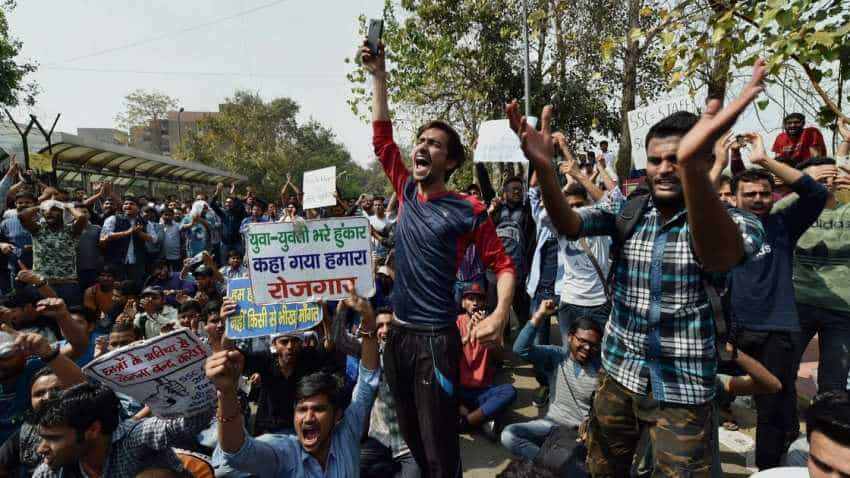Fitch flags high joblessness, rural distress due to GDP growth deceleration
The agency, which also affirmed the sovereign rating at BBB- with stable outlook, said the Reserve Bank will be on hold for the remainder of 2019 after Thursday's second consecutive 0.25 percent rate cut.

Global ratings agency Fitch Thursday said there has been a rise in unemployment in the country, and attributed GDP growth deceleration to domestic factors like weak manufacturing and dip in farmers' income. The agency, which also affirmed the sovereign rating at BBB- with stable outlook, said the Reserve Bank will be on hold for the remainder of 2019 after Thursday's second consecutive 0.25 percent rate cut. Commenting on the recent data showing a deceleration in growth, the agency said this is mainly driven by domestic factors, and emanates from weak manufacturing and low food inflation weighing on farmers' incomes.
It further "limited available indicators" also point to a "rise in unemployment". The comments on rural incomes and rise in unemployment come amid the election campaigns where the issue of low job creation has gained greater prominence, with the Opposition attacking the government performance. There have been concerns over jobless growth, which were also voiced by the then labour minister Bangaru Dattatreya in 2017.
Citing a study by Association for Democratic Reforms, former RBI governor Raghuram Rajan had last week said that jobs is the biggest issue in the elections.
A study by the Centre for Monitoring the Indian Economy had said as many as 1.1 crore jobs were lost in 2018 alone. The government has been citing the growth in EPFO registrations to stress on how jobs have increased and hiding negative dataprints on jobs and even growth.
On the rural economy front, farmers have taken out marches and protested in various pockets of the country over a slew of matters. The government has announced an income support scheme to farmers ahead of the elections.
The agency, whose research arm had earlier voiced doubts over the incumbent Narendra Modi government retaining power, said the elections will create a temporary uncertainty about the policy agenda, it said. However, the agency noted that governments of all hues have been reform-minded in the last 30 years.
Pointing out to opinion polls predicting a narrower majority for the next government which will make it difficult to carry out reforms like GST, it said "however, there seems plenty of potential for a continued focus on reforms."
It credited the Modi government for carrying out ambitious reform like GST and the bankruptcy law and also added that there has been a reduction in red tape which has reduced transactions costs.
The agency said GDP growth averaged 7.5 percent in the five years to FY19, which is more than twice the 3.6 percent median growth in the 'BBB' peer grouping.
It blamed a "weak fiscal position" as the factor constraining the sovereign rating and underlined that the next government's medium-term fiscal policy will be a keen factor to watch.
Governance standards remain weak, as illustrated by a low score for the World Bank's governance indicator, it said, pointing out that India is 47th percentile versus the 'BBB' median of 59.
The country's ranking on the UN Human Development Index (32nd percentile vs the 'BBB' median of 67) also indicates relatively low basic human development, it said.
Modest fiscal slippages over the targeted levels have stalled fiscal consolidation, it said, adding campaign promises like supporting farmers' incomes will add to spending pressures in FY20.
The agency said it expects headline inflation to average 3.8 percent in FY20 and that the central bank will look for opportunities to ease further, even though its baseline projection is for a hold for remainder of 2019.
The capital injection by an additional 0.6 percent of GDP in FY19 provides banks with a near-term reprieve, it said, adding this has aided the pick-up in credit growth in recent months to 12.9 percent in January.
Bad loans have improved to 10.8 percent in December 2018 from 11.5 percent in March, but the overhang of the over USD 150 billion in stressed assets will be a concern, it said. Even though the stress among NBFCs has receded, the sector's ability to provide credit seems reduced, it said.
Watch this Zee Business Video
The agency expects current account deficit to come in at 2.3 percent in FY19, and underlined India is not immune to emerging-market turmoil, as illustrated by the recent rupee depreciation.
Get Latest Business News, Stock Market Updates and Videos; Check your tax outgo through Income Tax Calculator and save money through our Personal Finance coverage. Check Business Breaking News Live on Zee Business Twitter and Facebook. Subscribe on YouTube.
RECOMMENDED STORIES

Rs 3,500 Monthly SIP for 35 years vs Rs 35,000 Monthly SIP for 16 Years: Which can give you higher corpus in long term? See calculations

SBI 444-day FD vs PNB 400-day FD: Here's what general and senior citizens will get in maturity on Rs 3.5 lakh and 7 lakh investments in special FDs?

SCSS vs FD: Which guaranteed return scheme will give you more quarterly income on Rs 20,00,000 investment?

Small SIP, Big Impact: Rs 1,111 monthly SIP for 40 years, Rs 11,111 for 20 years or Rs 22,222 for 10 years, which do you think works best?
06:47 PM IST










 Strong bank loan growth in FY23 despite higher interest rates: Fitch
Strong bank loan growth in FY23 despite higher interest rates: Fitch Budget to indicate new govt's intent on stepping up reforms, sticking to fiscal discipline: Fitch
Budget to indicate new govt's intent on stepping up reforms, sticking to fiscal discipline: Fitch Did Fitch just threaten to downgrade India's rating?
Did Fitch just threaten to downgrade India's rating? Fitch Ratings lowers India's FY19 growth forecast to 7.2%
Fitch Ratings lowers India's FY19 growth forecast to 7.2% Fitch credit rating for India remains unchanged for 12th year in a row
Fitch credit rating for India remains unchanged for 12th year in a row